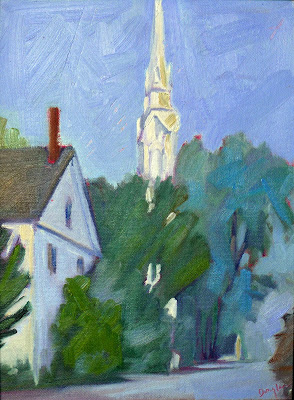Art theory is great, but workshops and classes should give you a clear process by which you can design and produce a better painting.
| Blueberry Barrens, Carol L. Douglas, available through Maine Farmland Trust Gallery. |
Natalia Andreeva is organizing my Find Your Authentic Voice in Plein Air workshop in Tallahassee in November. She asked me for objectives. That was great timing on her part. I leave for the Pecos National Wilderness Saturday night and then head to Acadia National Park in two weeks.
The list (which follows) is short, but it took me more than a day to write. That, in turn, led me to redesign my workshop process. I already had a good reputation as a teacher, but this year has radically sharpened my focus. For that I can thank lockdown.
 |
| Ocean Park Beach Erosion, available through Ocean Park Association. |
The biggest problem in plein air painting is what my buddy Brad Marshall once memorably referred to as “flailing around.” It’s easy to get stuck in the tall grass. In my opinion, the only classes worth taking are ones that give you a clear process by which you can design and produce a better painting. I love art theory and history, and I share them with my students. However, they have little to do with the mechanics of making a good picture.
Nor am I very interested in ‘style.’ To me that’s very personal—it’s what’s left when we’ve pushed our technique to the highest limit. When people try to teach it, they just create a small army of copyists.
| Parrsboro Dawn, available through the artist. |
I’ve always focused on practical painting, but Natalia’s question got me thinking about the how and why. These are the objectives I came up with:
Finish a painting in three hours or less
Working fast (and well) in the field requires a clear, easily-understood process. We’ll go through the steps, explain why they’re important, and practice each one.
Better composition
A good painting has a structure of lights and darks with clear focal points. We talk about how to improve the structure of your painting, both with rules and by breaking rules.
Accurate, fast color mixing
Mixing right the first time is the key to beautiful, clear color. Theory is important, but how do you apply it with the paints on your palette?
 |
| Sea Fog, available through Folly Cove Fine Art. |
Landscape perspective and pictorial distance
A sense of space sets off the best paintings. Learn to create that using drawn and aerial perspective.
You don’t need to record everything you see
What you leave out is as important as what you include. Learn to lose edges and direct the viewer’s eyes where you want them.
Let your own voice shine through
Process-based painting is all about technique, not style. That allows your own inner voice to emerge.
